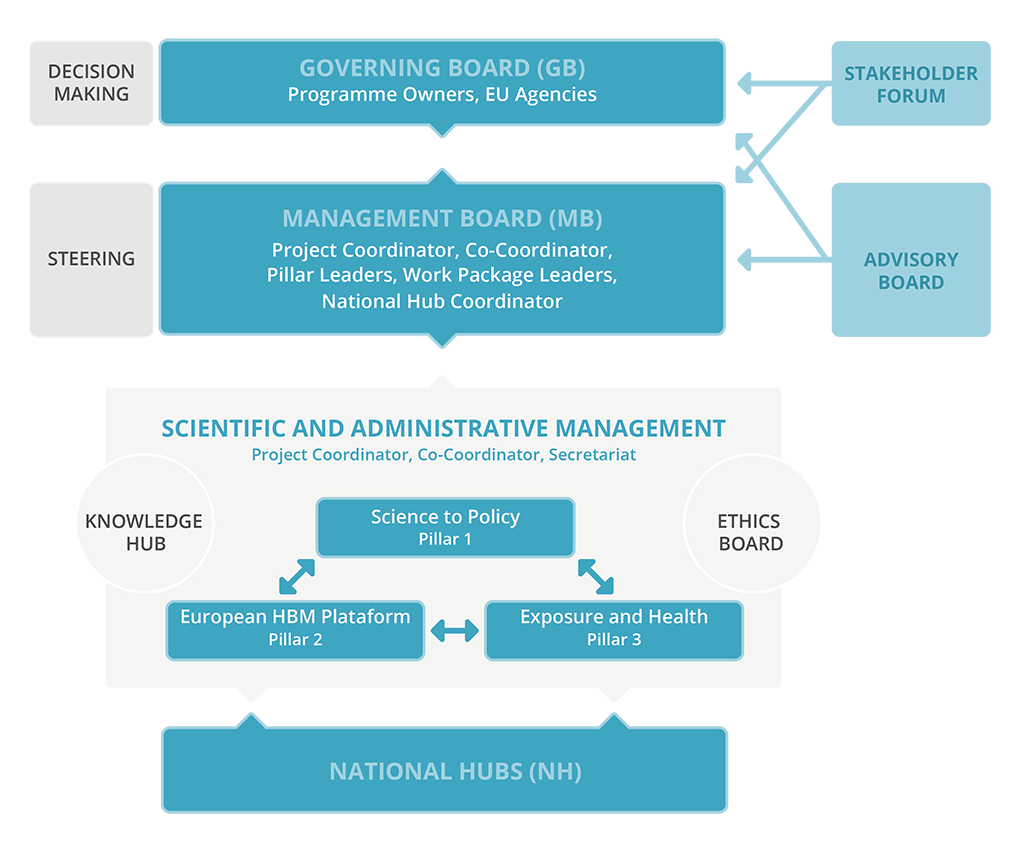The HBM4EU Project Coordinator is the German Environment Agency.
VITO is the co-coordinator of the project.
The consortium brings together leading European expertise on human biomonitoring from 24 European Union Member States, as well as Norway, Iceland, Israel and Switzerland. To view the list of National Hubs click here. The European Environment Agency also is a partner in the consortium. To view the full list of partners, please click here.
The HBM4EU governance structure includes the following bodies:
- Governing Board: Programme owners in the participating countries, the European Chemicals Agency, the European Environment Agency and the European Food Safety Authority.
- Scientific and Administrative Management: the Project Coordinator is supported by the Secretariat, the Co-coordinator, and the Management Board.
- National Hubs: a long-term network bringing together national HBM activities and ensuring that they are coordinated, feed their national needs into the European process, contribute to the objectives and learn from the work done in HBM4EU. To view the list of National Hubs click here.
- Stakeholder Forum: representatives of stakeholders from outside the project that will participate in the prioritization process and provide strategic input in order to enhance the accountability and credibility of our activities.
- Advisory Board: including international HBM experts with knowledge and experience to contribute to the project.
- Ethics Board: composed of specialists in ethics and in legal matters.
HBM4EU governance structure

HBM4EU activities are organised into sixteen work packages. Three work packages are concerned with programme management and coordination, the knowledge hub and the management of internal calls.
The remaining thirteen work packages are clustered under three pillars. For further details on the activities of the pillars and the work packages, click here.
- Pillar 1 on science to policy is led by VITO.
- Pillar 2 on the European human biomonitoring platform is led by the Institute of Health Carlos III (ISCIII).
- Pillar 3 on exposure and health is led by the National Institute of Health and Medical Research (INSERM).
The three Pillar Leaders are responsible for the coordination of activities within their respective Pillars, as well as across the Pillars.
The Work Package Leaders are responsible for the coordination and implementation of their respective Work Package.
Each Work Package is broken down into a number of discrete tasks, with Task Leaders responsible for their implementation.
For each priority substance group, a Chemical Substance Group Leader has been identified, based on their expertise and knowledge. The Chemical Substance Group Leaders contribute to the elaboration of the Annual Work Plan by providing advice on research tasks that address policy relevant questions for the substances under their remit.
Policy makers will be systematically involved in all stages of the project through an ongoing dialogue. Consultation with national and regional policy makers is organised through the National Hubs.
Consultation with EU level policy makers is organised in collaboration with the EU Policy Board. A broad range of EU services are represented on this board, including:
- Directorate-General for Health and Food Safety
- Directorate-General for Environment
- Directorate-General for Internal Market, Industry, Entrepreneurship and SMEs
- The Joint Research Centre
- Directorate-General for Employment, Social Affairs and Inclusion
- Directorate-General for Research and Innovation
- The European Environment Agency
- The European Food Safety Authority
- The European Chemicals Agency
Disclaimer
The HBM4EU project was launched in 2016 with the aim of improving the collective understanding of human exposure to hazardous chemicals and developing HBM as an exposure assessment method. The project had €74m in funding and jointly implemented by 120 partners from 28 participating countries – 24 EU member states plus Norway, Switzerland, Iceland and Israel and the European Environment Agency. One of its aims was to ensure the sustainability of HBM in the EU beyond 2021. The project ended in June 2022. The website will not be updated any longer, except the page on peer reviewed publications, but will be online until 2032.


